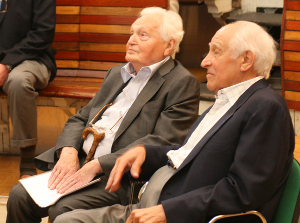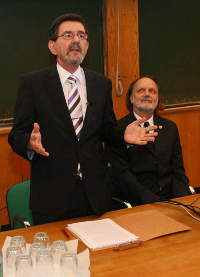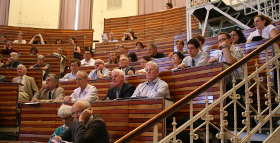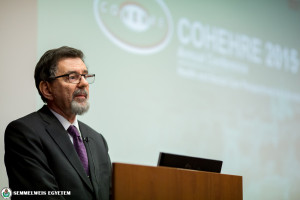The University’s Department of Human Morphology and Developmental Biology was witness to a special summoning of the past on July 6-7, 2011, when noted students and followers of Dr. Tivadar Huzella held a large-scale scientific conference in remembrance of this former director of the Department. While earlier, it had been believed that the substance between living cells is inanimate and unstructured adhesive material, Dr. Tivadar Huzella and his student Dr. Endre Balázs recognised that, due to its hyaluronic acid content, this so-called biomatrix has a huge role in the aging process. In the vitreous body, the joint cartilage, the skin, and numerous other places, it is not the cell, but rather the substance between the cells that plays the most important role; the biochemical correction or replacement of this material may even serve as an antidote to aging.
 Following World War II, Dr. Balázs fled from the fascist and communist dictatorships, emigrating first to Sweden and then to the United States. Here, he enjoyed a remarkable career in both science and business, the most important stages of which include: president of the Retina Foundation (Boston, U.S.), editor-in-chief of the leading ophthalmic journal Experimental Eye Research, professor at Columbia University (New York, U.S.), and founding president of Biotronics Inc.
Following World War II, Dr. Balázs fled from the fascist and communist dictatorships, emigrating first to Sweden and then to the United States. Here, he enjoyed a remarkable career in both science and business, the most important stages of which include: president of the Retina Foundation (Boston, U.S.), editor-in-chief of the leading ophthalmic journal Experimental Eye Research, professor at Columbia University (New York, U.S.), and founding president of Biotronics Inc.
As professor emeritus, the doyen of intercellular research and creator spiritus of the present conference, Dr. Balázs has returned to our university in order to pay his respects to his former teacher. Armed with a tireless enthusiasm that belies his 91 years, Dr. Balázs not only organised the conference, but also added great distinction to the event with his presence. In his opening address, Dr. Balázs praised the merits and role of the Department’s former director and outlined the past, present and future of biomatrix research.
 The conference was opened by Dr. István Karádi, dean of the Faculty of Medicine, followed by Dr. Ágoston Szél, current director of the Department and vice-rector for general affairs, who welcomed the guests and outlined the arc which Dr. Huzella’s teaching and research work had started and which, thanks to the work of Dr. Imre Törő, Dr. Béla Halász and Dr. Imre Oláh, is today inevitably present among leading biomedical innovations and in Semmelweis University’s curriculum.
The conference was opened by Dr. István Karádi, dean of the Faculty of Medicine, followed by Dr. Ágoston Szél, current director of the Department and vice-rector for general affairs, who welcomed the guests and outlined the arc which Dr. Huzella’s teaching and research work had started and which, thanks to the work of Dr. Imre Törő, Dr. Béla Halász and Dr. Imre Oláh, is today inevitably present among leading biomedical innovations and in Semmelweis University’s curriculum.
Some of the most famous biomatrix experts attended this two-day conference, including Dr. András Falus, director of the Department of Genetics, Cell- and Immunobiology and Dr. László Módis, professor at the University of Debrecen, in order to discuss the clinical significance of the intercellular substance described by Dr. Huzella in the 1930s. Touching reminiscences were given by Dr. Sándor Szirmai and Dr. László Róbert, former students of Dr. Huzella, while Dr. István Hargittai presented a fascinating science policy analysis, including the description and criticism of a problematic era in Hungarian history.
 Those who attended the conference enjoyed one of the summer’s most decisive events, which was worthy of not only the traditions of Semmelweis University, but the “Research University” title presented to the University last year as well.
Those who attended the conference enjoyed one of the summer’s most decisive events, which was worthy of not only the traditions of Semmelweis University, but the “Research University” title presented to the University last year as well.
The Department’s current director wishes to express his gratitude to Dr. Endre Balázs, Dr. Gábor Palkovics and Dr. István Hargittai, without whose intellectual and financial support this conference would not have been possible.
Dr. Ágoston Szél
Holder of the Huzella Award
(Translated by Gina Gönczi)

